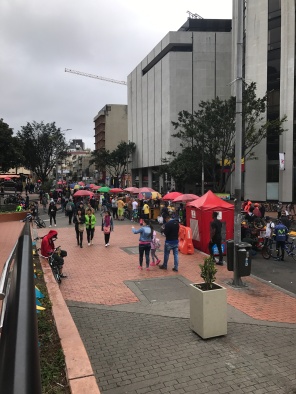Nearly sixty years ago, Jane Jacobs wrote that “designing a dream city is easy; rebuilding a living one takes imagination.” Her work is the basis for city planning across the world. She advocated dense, walkable, and authentic neighbourhoods. She demanded that our places make use of their uniqueness. She humanised place. Above all, she demonstrated through her own actions that people must be involved in our cities’ futures.
Joining the Committee to Save Washington Park moved Jacobs from criticism to activism. It also helped stop Robert Moses. New York’s “master builder” wanted to drive the Lower Manhattan Expressway through the heart of Greenwich Village. Jacobs became a hero to people who believe that our places are nothing without the human beings who live and work there.

Cliclovia, Bogotá – 29 July 2017
This idea is now central to how our cities are changing. Yet, too often, “urban regeneration” as actually delivered by cities ends up destroying the very distinctiveness and authenticity upon which their vibrancy depends. Development is not always regeneration. Development that takes no account of the place in which it happens is not regenerating anything. Development very often has “no hint of individuality or whim or surprise, no hint that here is a city with a tradition and flavor all its own”; more words from Jacobs.
Regeneration, by its very meaning, has to reflect what has come before. Ensuring an authentic sense of place means making reference to a city’s past. That is not the same as being trapped by the past. It simply means that character and distinctiveness do not magic themselves out of thin air.
An authentic sense of place also means involving people. Successful cities are the ones with the confidence to use the imaginations of their people. They recognise the two key lessons of Jacobs’ work: that distinctiveness is crucial and that people have to be involved in how our places are shaped.
Winston Churchill said, “We shape our buildings and afterwards our buildings shape us.” He may as well have been talking about place. The very character of our places affects us as people. Hanoverians are different from Berliners because its maritime heritage is different from Berlin’s political one; Angelenos are different from New Yorkers because of sunshine and beaches versus skyscrapers and pastrami; Belfastians are different from Edinburghers because of ships and linen against a castle and Adam Smith.
No formula exists for character or sense of a place. Nor is there is an easy way to measure it. But we absolutely know it when we see and feel it.
We know that it combines the tangible and intangible, the ordinary and extraordinary. It is, in varying degrees for various people, the look and feel of buildings, whether stone, brick or glass, the ways in which we use or don’t use our public spaces, maritime or landlocked, industrial grit or genteel merchant city.
More than anything else, it is people who articulate that character. Through the stories we tell and the welcomes we provide, people give a face to that character. So if our places have the power to shape us as people then we must have the power to shape our places.
A little over a week ago I embarked on a Winston Churchill Fellowship to explore how cities involve people in their regeneration. The research is built around two projects with which I’m involved. Successful Belfast is encouraging people to be involved in Belfast’s future in enterprising ways. Belfast City of Music has the ambition of telling the city’s story through music on an international stage.
Successful cities have a vibrancy built from a distinctive identity and civic participation. My travels will take me to six such cities in Colombia and the US. They will involve exploring the enterprising work encouraged by the Knight Foundation based in Miami, learning about Citizen Culture and the City of Music programme in Bogotá, seeing the work of the Moravia Cultural Centre in Medellín, looking at a city centre car park experiment in Lexington, experiencing the amazing energy of Chattanooga as ‘Enterprise City’, and finding out what makes Nashville tick as ‘Music City’.
All of it is possible because Churchill believed in the power of people to deliver change. Churchill also had the confidence to be Churchill. We must make sure that we have the confidence to truly regenerate our cities in authentic and meaningful ways. We must use the stories and energies of people to shape that regeneration.
Peter Ackroyd writes in “Venice: Pure City” that all cities “began as cemeteries.” It might be extreme, though accurate in the case of Venice, but the sentiment he is expressing, that all cities have a past, holds true. It means that we need to use that past to make sure that our cities remain living.
P.S. Applications for 2018 Winston Churchill Fellowships are open until 19th September. If you have an idea you want to explore, apply for the Fellowship!




